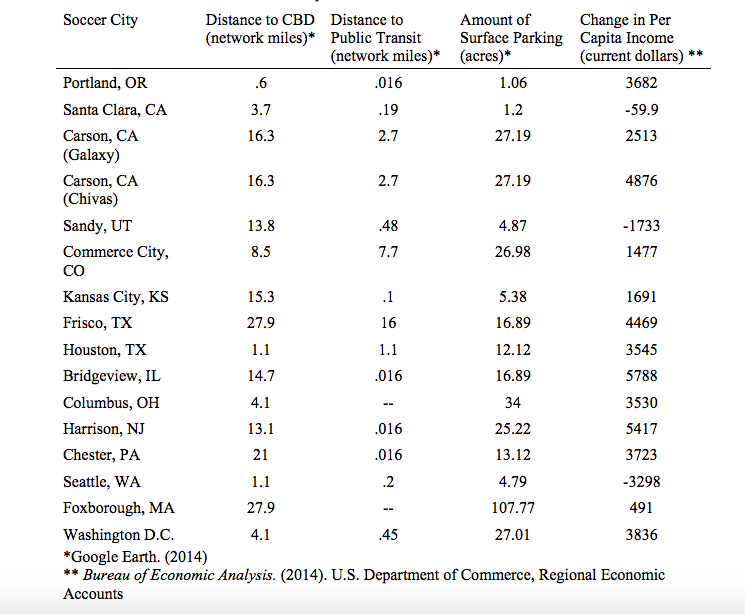Student Researches how Sports Stadiums Affect Communities
Having been awarded the RCP Outstanding Master’s Report, and now working to turn it into a journal article, recent RCP graduate Ryan Kacirek’s research can be summarized by one word: innovative.
His master’s report examines the the impact of planning and design that is valued by the college and the planning profession. Kacirek investigated whether the design of sports stadiums impacts the economy of the county the stadium is located in.
In his report, Kacirek paired counties with soccer stadiums with similar counties without stadiums,measuring the change in three economic measures over three years. Previous studies of the impact of design elements on the economy were primarily case studies of one stadium or comparative studies of two stadiums. This broader study is generalizable to the soccer stadiums that will soon be built in several cities and to other sports stadiums.
The above chart, featured in Kacirek’s report, shows stadium characteristics as independent variables
“Sports Stadiums are a hot topic for all sports,” Dr. Kate Nesse, Kacirek’s major professor, said. “Currently the Twin Cities is debating building a soccer stadium (where to build, how much the public should contribute, etc.) for the expansion team, Minneapolis United. It seems every large city has recently debated the contribution of public money to stadiums for football, baseball, basketball, and other sports. The stadiums get built but determining what will make them work well as parts of the city is important.”
He found that for Major League Soccer stadiums in the US, there is no measureable impact on employment levels, the number of establishments or aggregate pay. This is an important finding because sports stadiums are often funded in part or in whole by cities, counties and states.
When stadiums are built, the hope is that they will generate additional jobs and sales that will result in higher tax revenues, repaying the public body for its investment. Although it has long been argued that stadiums do not have enough economic impact to pay for the cost of the stadium, recently scholars have focused on how the design of the stadium related to the impact. Kacirek’s findings of no measureable impact from three major design elements of stadiums pushes the knowledge in this field forward.
Although he found that the design elements did not impact the economy, he argues that stadiums should, perhaps, be considered a social infrastructure investment and as such, be designed well to enhance the city and meet the needs of the population. Sports stadiums are not simply money generators but an important part of American culture.

“Some of our most iconic landmarks and beloved areas in the United States are centered around sports stadiums,” Kacirek said. “For example, when thinking of Boston, MA some may think of Fenway Park, the home of the Boston Red Sox of Major League Baseball as an iconic landmark in Boston. Fenway Park is not alone in being particularly distinguishable to its city’s identity. Across the major cities of the United States sports stadiums and arenas have become iconic to their city.”


